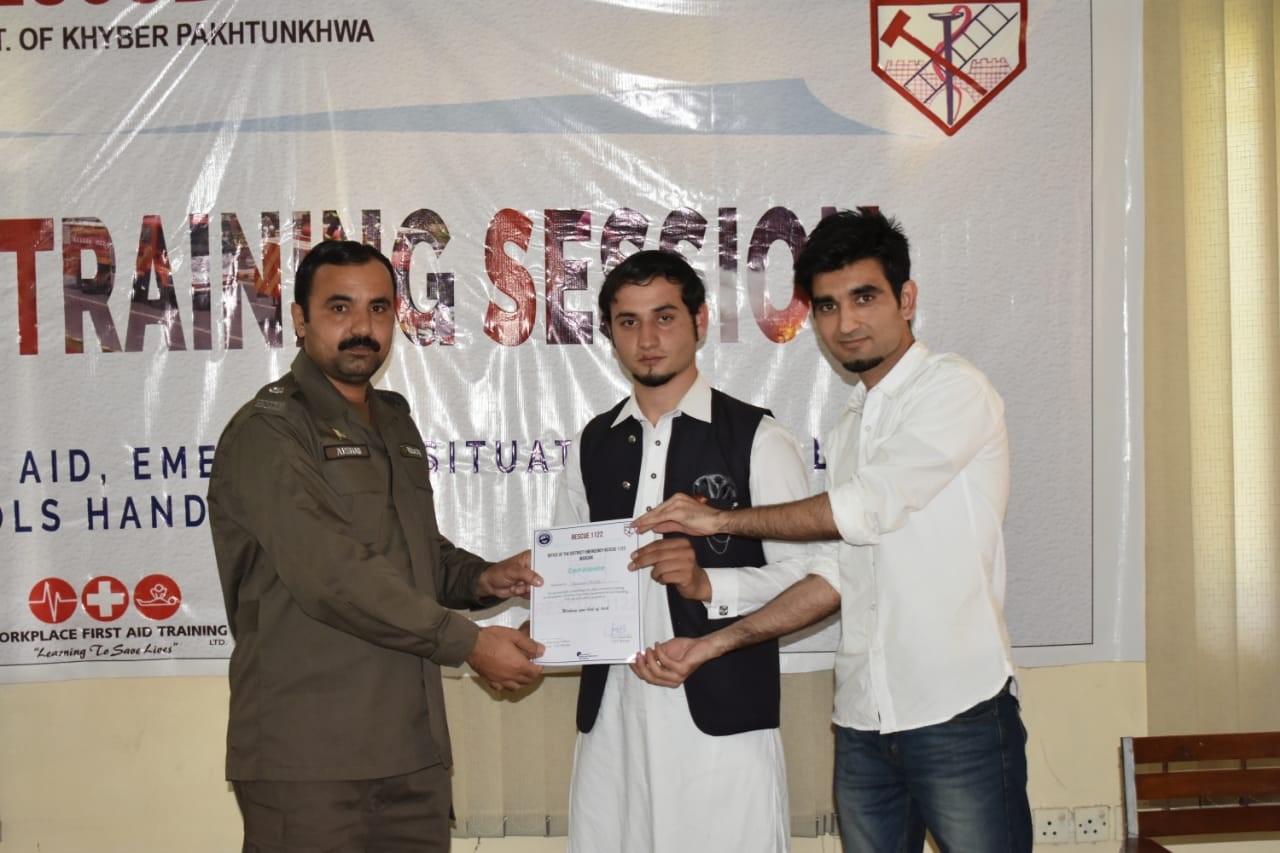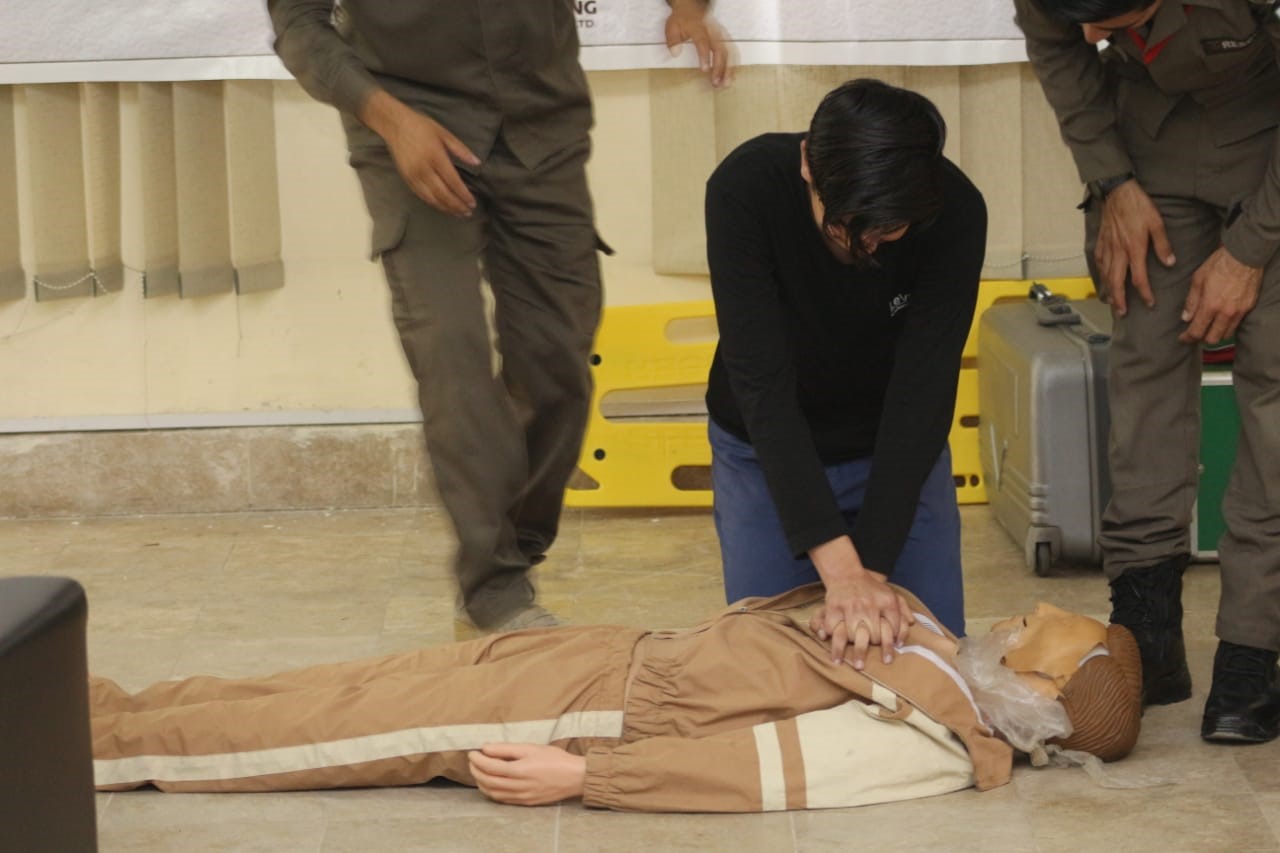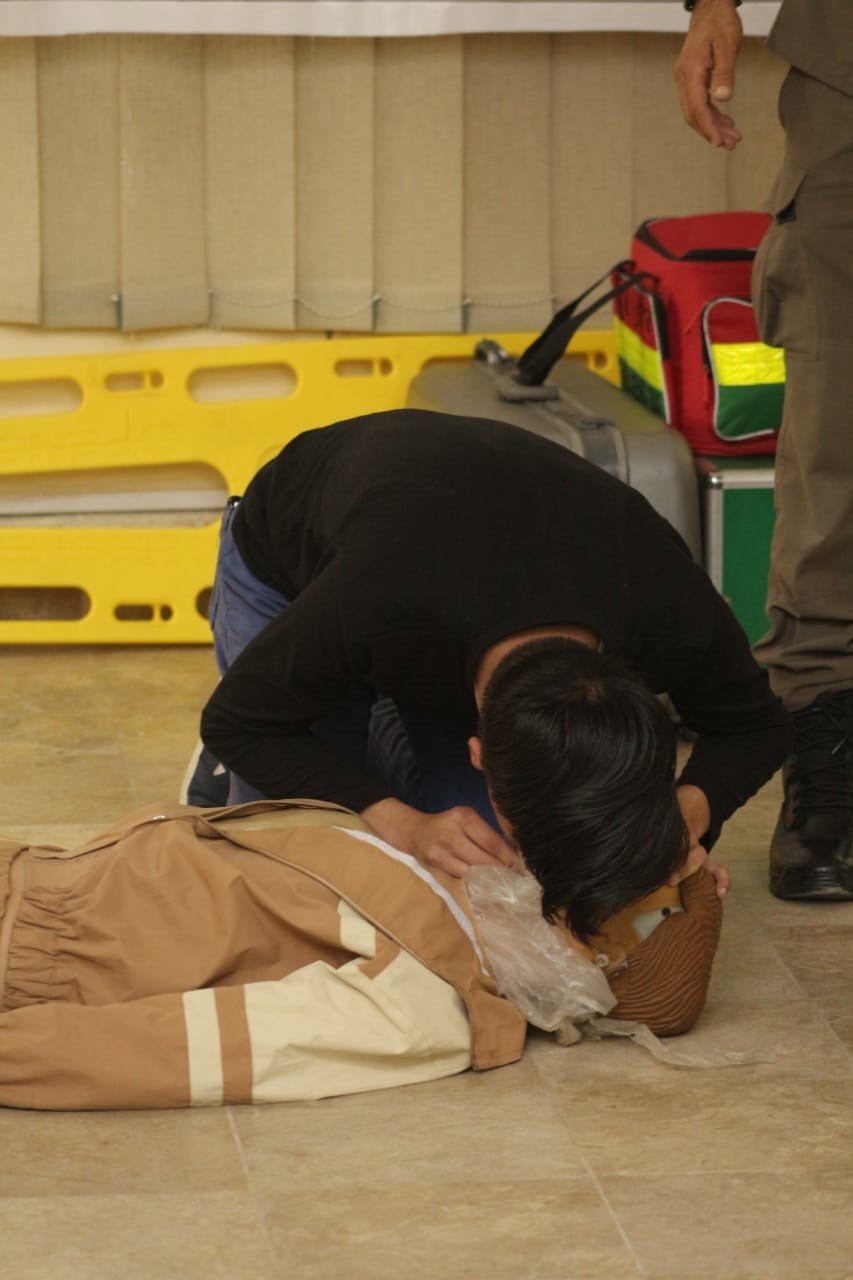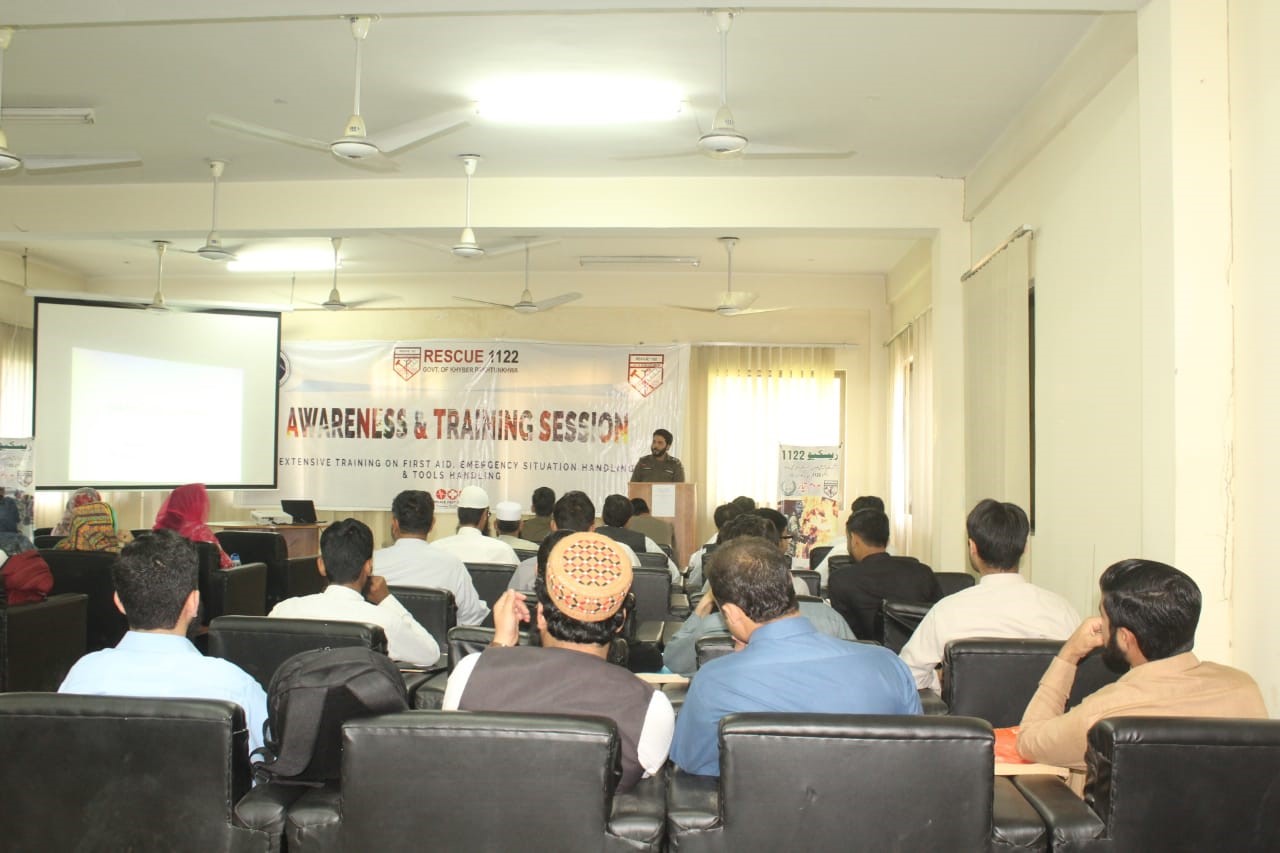Rescue 1122 Awareness & Training Session

Introduction
A two-day awareness and training session was held in University of Engineering & Technology, Mardan by the Office of District Emergency Rescue 1122 Mardan on 19th and 22nd April, 2019. The session intended to provide extensive training on emergency situation handling, first aid, safety assurance and equipment & tool handling. Rescue 1122 team explained different scenarios and practical demonstration was given how to handle any emergency.
Objective of Training
The main objective of the training was based on the fact that in any tragedy, even before the emergency rescue teams arrival, what the first responders needs to do. Intelligent and correct handling of the situation by the first responders can save a lot of damage whereas a wrong step by them can also lead to life-lasting damage. Thus awareness and training of general public is necessary. And as a part of this mission, a session was also held at UETM to inform, educate and train the students & teachers about emergency situation response and first aid.
Training Session
Three instructors were conducting the session. Different scenarios and their consequences were first explained by them, followed by the recommended response of the general public present at the scene. Extensive explanation of these practices and step-by-step demonstration of the situation was explained by the instructors. At the end of two day training, successful completion of the training by the participants, certificates were distributed among the participants & trainers. Appreciation certificates were also given to the instructors and the senior officers of Rescue1122 by the university and humble request for continuation of such sessions will be made in future.
Topics covered in the Training
A broad spectrum of emergency situations were covered in the session. On the first day, proper training on how to identify a cardiac arrest, giving CPR and handling choking patients were given. The situations were individually explained for adults and toddlers. Step-by-step practical demonstration of these practices were shown by the instructors and students were also made to practice.
On the second day of training, education and training for following situations were given: bleeding, fractures, poisoning, & penetration of impaired objects in body. In addition to them, information on response and first aid in case of drowning and electric shocks was also given.
An extensive session on handling fire accidents was also held. Practical demonstration of bucket chain method and use of extinguishers was given. Then participants were also given the chance to practice.
The following topics were during the training
- How to stop the flow of bleeding or Management of the bleeding control skills (Internal bleeding and external bleeding).
- Shock and types of the shock, Management of the shock.
- Air Way management, (head tilt and chin left, jaw thrust).
- Initial Assessment of the patient /victim.
- Recovery position.
- Adult CPR, INFANT and child
- FBAO of Adult, Infant, Child, Pregnant women and obese victim.
- Fracture Management.
- Electric shock management.
- Drowning case management.
- Burn case management.
- Triage system.
- Casualty Handling and Transportation Techniques.
- Snake Bite case Management.
- Chest injury management and Abdomen.
- Fire Management.

Severe bleeding: First aid
For severe bleeding, take these first-aid steps and reassure the injured person.
- Remove any clothing or debris on the wound. Don't remove large or deeply embedded objects. Don't probe the wound or attempt to clean it yet. Your first job is to stop the bleeding. Wear disposable protective gloves if available.
- Stop the bleeding. Place a sterile bandage or clean cloth on the wound. Press the bandage firmly with your palm to control bleeding. Apply constant pressure until the bleeding stops. Maintain pressure by binding the wound with a thick bandage or a piece of clean cloth. Don't put direct pressure on an eye injury or embedded object. Secure the bandage with adhesive tape or continue to maintain pressure with your hands. If possible, raise an injured limb above the level of the heart.
- Help the injured person lie down. If possible, place the person on a rug or blanket to prevent loss of body heat. Calmly reassure the injured person.
- Don't remove the gauze or bandage. If the bleeding seeps through the gauze or other cloth on the wound, add another bandage on top of it. In addition, keep pressing firmly on the area.
- Tourniquets: A tourniquet is effective in controlling life-threatening bleeding from a limb. Apply a tourniquet if you're trained in how to do so. When emergency help arrives, explain how long the tourniquet has been in place.
- Immobilize the injured body part as much as possible. Leave the bandages in place and get the injured person to an emergency room as soon as possible.
Shock Management
Shock is a life-threatening medical condition as a result of insufficient blood flow throughout the body. Shock often accompanies severe injury or illness. Medical shock is a medical emergency and can lead to other conditions such as lack of oxygen in the body's tissues (hypoxia), heart attack (cardiac arrest) or organ damage. It requires immediate treatment as symptoms can worsen rapidly. Medical shock is different than emotional or psychological shock that can occur following a traumatic or frightening emotional event. Septic shock results from bacteria multiplying in the blood and releasing toxins. Common causes of this are pneumonia, urinary tract infections, skin infections (cellulitis), intra-abdominal infections (such as a ruptured appendix), and meningitis. Anaphylactic shock is a type of severe hypersensitivity or allergic reaction. Causes include allergy to insect stings, medicines, or foods (nuts, berries, seafood), etc. Cardiogenic shock happens when the heart is damaged and unable to supply sufficient blood to the body. This can be the end result of a heart attack or congestive heart failure. Hypovolemic shock is caused by severe blood and fluid loss, such as from traumatic bodily injury, which makes the heart unable to pump enough blood to the body, or severe anemia where there is not enough blood to carry oxygen through the body. Neurogenic shock is caused by spinal cord injury, usually as a result of a traumatic accident or injury.
There are several main causes of shock: Heart conditions (heart attack, heart failure), Heavy internal or external bleeding, such as from a serious injury or rupture of a blood vessel, Dehydration, especially when severe or related to heat illness. Infection (septic shock), Severe allergic reaction (anaphylactic shock), Spinal injuries (neurogenic shock), Burns and Persistent vomiting or diarrhea.
Call Rescue 1122 for immediate medical attention any time a person has symptoms of shock. Do not wait for symptoms to worsen before calling for help. Stay with the person until help arrives, and if possible, stay on the line with the Rescue 1122 dispatcher because they may have specific instructions for you. While waiting for help or on the way to the emergency room, check the person's airway, breathing and circulation (the ABCs). Administer CPR if you are trained. If the person is breathing on his or her own, continue to check breathing every 2 minutes until help arrives. Do NOT move a person who has a known or suspected spinal injury (unless they are in imminent danger of further injury).Have the person lie down on his or her back with the feet elevated above the head (if raising the legs causes pain or injury, keep the person flat) to increase blood flow to vital organs. Do not raise the head. Keep the person warm and comfortable. Loosen tight clothing and cover them with a blanket. Do not give fluids by mouth, even if the person complains of thirst. There is a choking risk in the event of sudden loss of consciousness. Give appropriate first aid for any injuries. Direct pressure should be applied to any wounds that are bleeding significantly.
Air Way management
Airway management is the process of ensuring that there is an open pathway between a patient’s lungs and the outside world, and the lungs are safe from aspiration. The simplest way of ensuring an open airway in an unconscious patient is to use a head tilt chin lift technique, thereby lifting the tongue from the back of the throat. Continue use of the head-tilt chin-lift. If there is no risk of spinal injury, it is preferable to use the head-tilt chin-lift procedure, which is easier to perform and maintain.

Initial Assessment of the patient /victim
At this stage the first aider, on approaching a victim should have:
- GO - Put their gloves on
- D - Checked for danger
- R - Checked for responsiveness
- S - Looked at the scene for clues about what has happened
- H - Gained history on the incident
- AVPU - Assessed to see how responsive the victim is.
Recovery positions
With the person lying on their back, kneel on the floor at their side. Extend the arm nearest you at a right angle to their body with their palm facing up. Take their other arm and fold it so the back of their hand rests on the cheek closest to you, and hold it in place. Use your free hand to bend the person's knee farthest from you to a right angle. Carefully roll the person onto their side by pulling on the bent knee. Their bent arm should be supporting the head, and their extended arm will stop you rolling them too far. Make sure their bent leg is at a right angle. Open their airway by gently tilting their head back and lifting their chin, and check that nothing is blocking their airway. Stay with the person and monitor their condition until help arrives.
If you think a person may have a spinal injury, do not attempt to move them until the emergency services reach you. If it's necessary to open their airway, place your hands on either side of their head and gently lift their jaw with your fingertips to open the airway. Take care not to move their neck. You should suspect a spinal injury if the person: has been involved in an incident that's directly affected their spine, such as a fall from height or being struck directly in the back, complains of severe pain in their neck or back, won't move their neck. feels weak, numb or paralyzed and has lost control of their limbs, bladder or bowels.
Electric Shock Management
An electric shock occurs when a person comes into contact with an electrical energy source.
Electrical energy flows through a portion of the body causing a shock. Exposure to electrical energy may result in no injury at all or may result in devastating damage or death. Many people get electric shocks obtained from man-made objects such as electrical appliances, electrical wires, and electrical circuitry. In addition, lightning strikes are a natural form of electric shock. Burns are the most common injury from electric shock and lightning strikes.
Donot touch the injured person if he or she is still in contact with the electrical current. Call Rescue 1122 or your local emergency number if the source of the burn is a high-voltage wire or lightning. Don't get near high-voltage wires until the power is turned off. Overhead power lines usually aren't insulated. Stay at least 20 feet (about 6 meters) away, farther if wires are jumping and sparking. Don't move a person with an electrical injury unless he or she is in immediate danger.
Take these actions immediately while waiting for medical help: Turn off the source of electricity, if possible. If not, move the source away from you and the person, using a dry, nonconducting object made of cardboard, plastic or wood. Begin CPR if the person shows no signs of circulation, such as breathing, coughing or movement. Try to prevent the injured person from becoming chilled. Apply a bandage. Cover any burned areas with a sterile gauze bandage, if available, or a clean cloth. Don't use a blanket or towel, because loose fibers can stick to the burns.
Fire Management
The Fire Triangle is actually it's a tetrahedron, because there are four elements that must be present for a fire to exist. There must be Oxygen to sustain combustion, Heat to raise the material to its ignition temperature, Fuel to support the combustion and a Chemical Reaction between the other three elements.
Using a Fire Extinguisher, the following steps should be followed when responding to incipient stage fire: Sound the fire alarm and call the fire department, if appropriate. Identify a safe evacuation path before approaching the fire. Do not allow the fire, heat, or smoke to come between you and your evacuation path. Select the appropriate type of fire extinguisher. Discharge the extinguisher within its effective range using the P.A.S.S. technique (pull, aim, squeeze, sweep). Back away from an extinguished fire in case it flames up again. Evacuate immediately if the extinguisher is empty and the fire is not out. Evacuate immediately if the fire progresses beyond the incipient stage. Most fire extinguishers operate using the following P.A.S.S. technique: PULL... Pull the pin. This will also break the tamper seal. AIM... Aim low, pointing the extinguisher nozzle (or its horn or hose) at the base of the fire. NOTE: Do not touch the plastic discharge horn on CO2 extinguishers, it gets very cold and may damage skin. SQUEEZE... Squeeze the handle to release the extinguishing agent. SWEEP... Sweep from side to side at the base of the fire until it appears to be out. Watch the area. If the fire re-ignites
Fire extinguishers are not always available, so it is important to know other ways to put out a fire. One technique used to smother a fire involves sand and a bucket. A fire-sand bucket is a steel bucket filled with sand. While this is a low-tech method of fighting a fire, it is usually very effective.
Staff and Students Participation
Throughout the training, students and teachers were encouraged and invited to practice all the methods taught in the session. The practices performed by participants included CPR, controlling bleeding, giving artificial breaths to drowning cases, immobilizing patients in case of fractures, giving thrusts in case of choking, handling impaired objects, and use of fire extinguishers. All these practices were performed in the supervision of the instructors, guiding and correcting the participants at every point.
Outcome of the Event
The main outcome of the event was giving basic knowledge, training that how to handle any emergency situation. In many cases it also leads to save precious lives. Information and training gained by the participants will not only be beneficial for themselves but extends to their family, friends, colleagues and even the community as a whole. Accidents may happens but by taking the necessary actions we can reduce the hazards and improve the safety.

